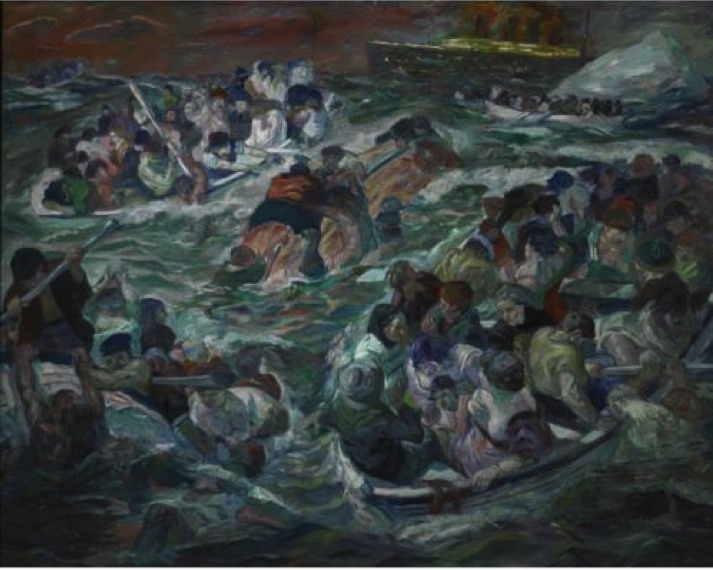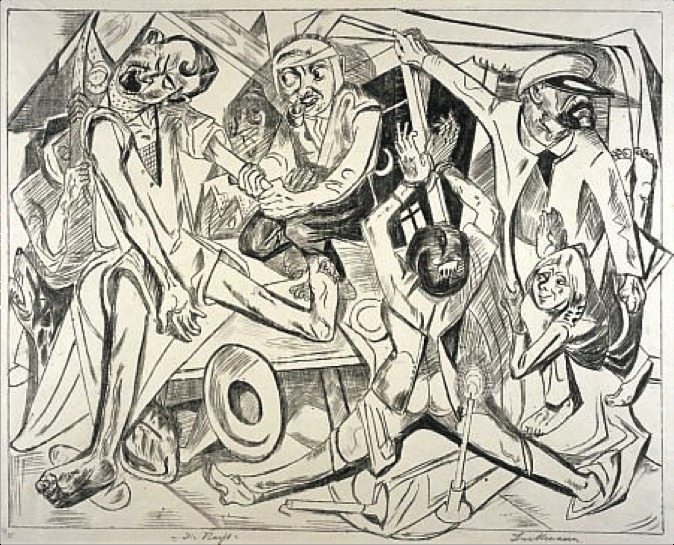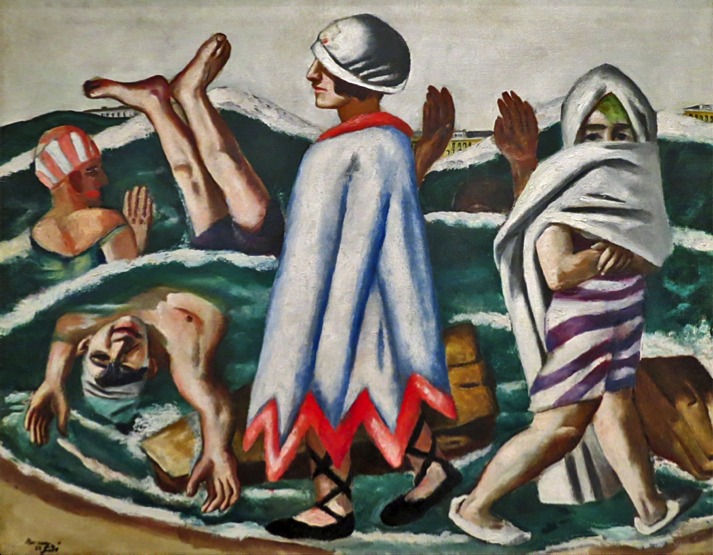A menagerie of fragmented bodies and covert glances, Max Beckmann’s Lido, 1924(Figure 1) presents quite a different take on the subject of bathers. Beckmann shows a leisurely beach scene on the coast of Italy – a lido, in Italian – rather than a scene that references idyllic landscapes or traditional nudes of his expressionist contemporaries. The green waves in the painting resemble the contoured topography in Day of Steel, 1911 (St. Louis Art Museum), and the bodies of the swimmers are immersed and positioned in this flattened environment that resembles Matisse’s surreal landscape in Bathers with a Turtle, 1907-8 (St. Louis Art Museum). Lido is Beckmann’s representation of “life as it simply exists” per his own expressionistic vision. It captures both the immediate beauty and mystery of the Italian lido in its crowded, modernist aesthetic. Moreover, it seems to contradict Beckmann’s proclamation of unbiased representation in its mysterious and tense atmosphere.

Figure 2. Max Beckmann, The Sinking of the Titanic, 1912-13
Oil on canvas, 104.25 x 130 in.
St. Louis Art Museum
A menagerie of fragmented bodies and covert glances, Max Beckmann’s Lido, 1924(Figure 1) presents quite a different take on the subject of bathers. Beckmann shows a leisurely beach scene on the coast of Italy – a lido, in Italian – rather than a scene that references idyllic landscapes or traditional nudes of his expressionist contemporaries. The green waves in the painting resemble the contoured topography in Day of Steel, 1911 (St. Louis Art Museum), and the bodies of the swimmers are immersed and positioned in this flattened environment that resembles Matisse’s surreal landscape in Bathers with a Turtle, 1907-8 (St. Louis Art Museum). Lido is Beckmann’s representation of “life as it simply exists” per his own expressionistic vision. It captures both the immediate beauty and mystery of the Italian lido in its crowded, modernist aesthetic. Moreover, it seems to contradict Beckmann’s proclamation of unbiased representation in its mysterious and tense atmosphere.
Beckmann began painting in the early twentieth century, and debuted a style that was in dialogue with previous masters of Romanticism and Impressionism.[1] Before the outbreak of World War I, he painted in a realistic and semi-impressionistic style with notes of Théodore Géricault and Eugene Delacroix’s romantic drama.[2] Beckmann’s painting The Sinking of the Titanic, 1912-13 (Figure 2) brings together these influences by depicting the chaotic shipwreck in painterly brushwork, and also by featuring a dramatically diagonal composition similar to Gericault’s Raft of the Medusa, 1818-19 (Paris. Louvre). Beckmann’s Young Men by the Sea, 1905 (Figure 3) also depicts a recreational seaside scene similar to the one in Lido, and this earlier work still features the classical nudity of bathers scenes and the impasto techniques of Impressionism and Post-Impressionism.

Figure 4. Max Beckmann, "Martyrdom," 1919, from Die Hölle series.
Lithograph, 87 x 61 cm
St. Louis Art Museum.
These earlier paintings by Beckmann stand in drastic contrast to his style after the outbreak of World War 1. Native to Germany, Beckmann was not one to meddle with politics, even during the highly contentious climate of the First World War. What affected him the most, however, were “the injuries of the soul” he suffered after witnessing the atrocities of World War I.[3] After his discharge in 1915, his style became characterized by violent distortion, gruesome subject matter and mysterious symbolism, and he also began to engage with the Cubist art of his contemporaries.[4] The foundations for his grotesque, disjointed style were established with prints such as Martyrdom from the series Hell, 1919 (Figure 4).[5] The bodies in Martyrdom are fragmented and jagged, and Beckmann creates a chaotic and claustrophobic aura through the collapse of conventional space. Beckmann’s stated goals for his post-war painting included making “the invisible visible through reality.” Max Beckmann achieved these transcendental goals through “the penetration of space,”[6] In these later compositions, the emotional, tormented lens through which he saw the world was thus laid out in one overwhelming plane. These prints and painting awaken life’s hidden misery and trauma. Beckmann’s imagery is grounded in the realities he witnessed, and he makes no effort to filter these visions for his viewers with traditional visual cues.
Beckmann painted Lido during his trip to Pirano, Italy in 1924, but the piece still bears the fundamental elements of Beckmann’s post-war style despite its seemingly tranquil environment. The color and texture of the waves are similar to the seascape in The Sinking of the Titanic, 1912-13 (Figure 2), but the diagonal, spatial recession that characterizes his earlier work is absent in Lido. The figures on the shore in the foreground seem to walk on the same plane as the rising waves. Beckmann’s figures are not depicted as classical nudes, but instead all reveal and conceal fragments of their bodies: the central figure – the artist’s second wife Quappi – is fully cloaked and her eyes are concealed by her cap, and the adjacent figure exposes and withdraws herself with white drapes and a coveted glance over her shoulder. The figures among the waves are quite literally fragmented, as only portions of the bodies protrude from beneath the waves. Pieces of broken wood float among the waves, and it is easy for a viewer to conflate the wooden scraps with the bathers’ body parts. This broken and claustrophobic space readily takes upon the uneasy composition of Beckman’s style in the lithograph Martyrdom, 1919 (Figure 4) and of his other paintings despite the seemingly lighter subject matter.
In this way, the ambiguous stares, collapse of space, and broken figures bastardize this scene that Beckmann wished to portray as realistic and “as lovely as possible.”[7] Beckmann’s tendency towards crowded, angular compositions contributes to the uneasy feelings that Lido evokes, and this underlying anxiety may echo simmering Italian nationalism and the ominous rise of fascism that the artist was exposed to during the 1920s.[8] The green, white and red of the Italian flag are repeated in Lido and many of his other Italian paintings, such as The Barque (Play of the Waves), 1926 (Private Collection). Beckmann states that during his trip to Italy, “it was through nature (and not through antiquity) that I arrived at a new way of depicting the essence of a situation.”[9] It is through this close observation that he distills the mysterious and calm “essence” of the 1920s Italian lido, and the resulting flat, enigmatic composition reflects Beckmann’s “esoteric impulse” in his perception of modern life.[10]
Beckmann’s fascination with life and scenes of modernity comes into conflict with many of the Fauvist and German Expressionist artistic impulses. Beckmann was highly critical of his French contemporaries’ seemingly frivolous and detached artistic endeavors, especially in light of the ravaging emotional trauma he experienced after World War I. In response to scenes of bathers, Beckmann stated that groups like the Fauves and The Bridge indulged in
…complete withdrawal in order to achieve that famous purity people talk about as well as the loss of self in god, right now all that is too bloodless and also loveless for me.[11]
The frivolous separation of artists such as Matisse and Pechstein from the realities of a tumultuous world clashes with the modern context of Beckmann’s bathers, who are captured in a real and recognizable modern environment. Beckmann’s vision is closer to the people around him rather than an escape from modern life or a grand salute towards antiquity and art history. Lido takes the concept of bathers as it arrives to Beckmann’s perception as “life as it simply exists:” in a bright yet mysterious composition that borders on surreal.
[1] Victor H. Miesel. Voices of German Expressionism. Englewood Cliffs, N.J.: Prentice-Hall, 1970, 105.
[2] Max Beckmann. On My Painting. London: Tate Publishing, 2003, 1.
[3] Meisel, Voices of German Expressionism, 105
[4] Miesel, Voices of German Expressionism, 105
[5] Stephanie Barron. German Expressionism 1915-1925: The Second Generation. Los Angeles, CA: Los Angeles County Museum of Art, 1988, 45
[6] Beckmann, On My Painting. London: Tate Publishing, 2003, 2.
[7] Judith C. Weiss and Carla Shulz-Hoffmann, eds. Max Beckmann: Retrospective (Saint Louis, MO: Saint Louis Art Museum, 1984), 227.
[8] Weiss and Shulz-Hoffmann, eds. Max Beckmann: Retrospective, 230.
[9] Sean Rainbird, ed. Max Beckmann (New York, NY: Museum of Modern Art, 2003), 90.
[10] Rainbird, Max Beckmann, 12.
[11] Miesel, Voices of German Expressionism, 108.

